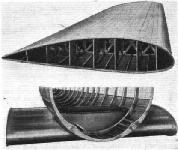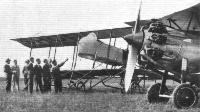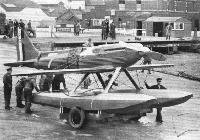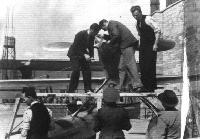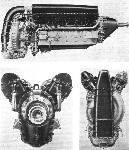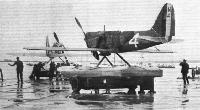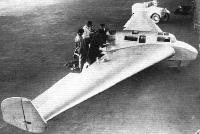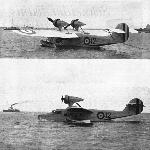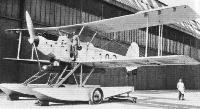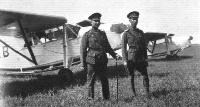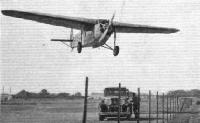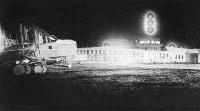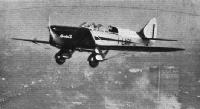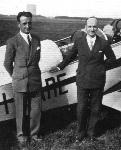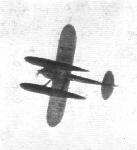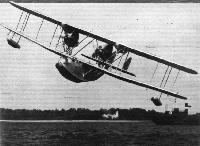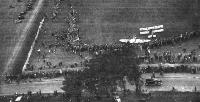Фотографии
-
The clean lines of the Alpha show well in this three-quarter front view.
Самолёты на фотографии: Northrop Alpha - США - 1930
-
The flat plate multicellular type of wing construction and manner in which the Alclad skin is built up over ring-shaped bulkheads in the fuselage.
Самолёты на фотографии: Northrop Alpha - США - 1930
-
General arrangement drawings of the Northrop Alpha as a land and seaplane.
Самолёты на фотографии: Northrop Alpha - США - 1930
-
OLD AND NEW: A 1914 R.A.F. Farman, and a 1931 R.A.A.F. Bristol "Bulldog." The Farman is owned by Mr. R. Graham Carey, of the Victorian Aero Club, who has had it re-conditioned for passenger carrying, etc. It is fitted with a 90 h.p. R.A.F. engine.
Самолёты на фотографии: Bristol Bulldog - Великобритания - 1927Farman Farman-30/40 - Франция - 1915
-
Регистрационный номер: S1596 [7] GOING AFTER THAT RECORD: The Supermarine Rolls-Royce S.6B, S.1596, being lowered down the slipway at Calshot for Stainforth's successful attempt to beat the speed record.
Самолёты на фотографии: Supermarine S.5 / S.6 - Великобритания - 1927
-
FUELLING: This view of one of the new Supermarine Rolls-Royce S.6 B machines gives a very good idea of the clean lines and small frontal area. Large quantities of petrol are carried in the floats, more in one than in the other, in order to counteract the propeller torque.
The two S.6Bs were powered by the 2,300 h.p. Rolls-Royce R.Самолёты на фотографии: Supermarine S.5 / S.6 - Великобритания - 1927
-
Регистрационный номер: S1596 [7] SCHNEIDER WINNER AND WORLD'S SPEED RECORD HOLDER: ONE OF THE SUPERMARINE ROLLS-ROYCE S.6B MONOPLANES BUILT FOR THIS YEAR'S CONTEST. THE MACHINE SHOWN IS S.1596 ON WHICH STAINFORTH ESTABLISHED A NEW SPEED RECORD. BOOTHMAN S MACHINE IS IDENTICAL.
Самолёты на фотографии: Supermarine S.5 / S.6 - Великобритания - 1927
-
CHANGING A PROP: As in previous years, the Fairey Aviation Company has supplied all the metal airscrews for the Schneider machines.
Самолёты на фотографии: Supermarine S.5 / S.6 - Великобритания - 1927
-
Регистрационный номер: S1595 [4] CHAIRING THE WINNER: Flt. Lt. Boothman receives enthusiastic support on his return to Calshot after completing the Schneider course.
Самолёты на фотографии: Supermarine S.5 / S.6 - Великобритания - 1927
-
A BRITISH TRIUMPH OF ENGINEERING: The Rolls-Royce "R" type racing engine fitted in the Schneider machines has been developed from the "H" type, but gives well over 2,000 h.p. for a weight of rather less than three-quarters of a pound per horsepower. The engine is geared and supercharged. In the upper photograph the supercharger can be seen on the left, while the two lower photographs show the engine from the front and from the rear.
Самолёты на фотографии: Supermarine S.5 / S.6 - Великобритания - 1927
-
Регистрационный номер: S1595 [4] GOING OUT: Boothman's Supermarine Rolls-Royce S.6B being towed to the starting point on one of the special pontoons.
Самолёты на фотографии: Supermarine S.5 / S.6 - Великобритания - 1927
-
Регистрационный номер: S1596 [7] GETTING OVER THE "HUMP": Flt. Lt. Stainforth taking off in S.1596.
Самолёты на фотографии: Supermarine S.5 / S.6 - Великобритания - 1927
-
Регистрационный номер: S1595 [4] Самолёты на фотографии: Supermarine S.5 / S.6 - Великобритания - 1927
-
Регистрационный номер: S1596 [7] AT 400 M.P.H.: Stainforth approaching the 3 km. course during his flight on September 13, when he raised the straight-line record to 610.01 km./h. (379.05 m.p.h.). When the special engine has been installed in the machine another attempt will be made.
Самолёты на фотографии: Supermarine S.5 / S.6 - Великобритания - 1927
-
Регистрационный номер: S1596 [7] HEADING FOR THE LINE: Stainforth's Supermarine Rolls-Royce S.6B snapped while getting ready to enter the speed course.
Самолёты на фотографии: Supermarine S.5 / S.6 - Великобритания - 1927
-
Регистрационный номер: S1595 [4] BOOTHMAN PASSING OVER THE SHORE AT SOUTHSEA: The beach was lined with spectators.
Самолёты на фотографии: Supermarine S.5 / S.6 - Великобритания - 1927
-
Регистрационный номер: S1596 [7] A GOOD JOB WELL DONE: Flt. Lt. G. H. Stainforth returns to Calshot after establishing the new world's speed record. The photograph shows rather well the somewhat unusual shape of the Fairey metal airscrew. The pitch, it will be noticed, is quite perceptible.
Самолёты на фотографии: Supermarine S.5 / S.6 - Великобритания - 1927
-
Регистрационный номер: N248 "POSTPONED ON ACCOUNT OF WEATHER": Scene at Calshot on Saturday last. The Schneider machines are wearing their raincoats.
Самолёты на фотографии: Supermarine S.5 / S.6 - Великобритания - 1927
-
Регистрационный номер: N219 TRAINING: One of the 1927 Supermarine-Napier S.5 machines, N.219, going off on a practice flight.
Самолёты на фотографии: Supermarine S.5 / S.6 - Великобритания - 1927
-
Регистрационный номер: S1596 [7] READY TOR LAUNCHING: S.1596 on one of the special pontoons used for transporting the machines from Calshot to the point of take-off.
Самолёты на фотографии: Supermarine S.5 / S.6 - Великобритания - 1927
-
NOT A SUBMARINE - BUT SUPERMARINE: Salving the Vickers-Supermarine S.6B from Southampton water, little the worse for its ducking.
Самолёты на фотографии: Supermarine S.5 / S.6 - Великобритания - 1927
-
A NEW TAILLESS AIRCRAFT: Herr Lippisch, chief designer of the Rhon-Rossitten Ges., has produced this new tailless aircraft at the Wasserkuppe. After considerable trials as a glider it was fitted with a Siemens engine and has now been taken by Herr Koehl, of trans-Atlantic fame, to Berlin. It is exceptionally clean and highly efficient as one would expect from the designer of the world's most successful gliders such as the Wien and the Fafnir.
Самолёты на фотографии: Lippisch Delta I - Германия - 1930
-
A FINE ATTENDANCE: Sywell from the air, showing the large number of aircraft which attended the All Women's Meeting. In the left foreground is a Comper Swift (Pobjoy) and two Redwings (Genet). Formations of three of each of these aircraft were a feature of the meeting.
Самолёты на фотографии: Comper Swift / CLA.7 - Великобритания - 1930Robinson Redwing - США - 1930
-
Регистрационный номер: S1592 SCHNEIDER RECONNAISSANCE: A Fairey "Firefly" (Rolls-Royce "Kestrel") used for testing conditions. It also gave a demonstration of aerobatics on the day of the Contest.
Самолёты на фотографии: Fairey Firefly - Великобритания - 1925
-
THE LATEST SARO "CLOUD": Two views of the machine on the water. The engines are Armstrong-Siddeley "Double Mongoose," and the estimated performance of the machine has been considerably exceeded.
Самолёты на фотографии: Saunders-Roe Cloud / A.19 - Великобритания - 1930
-
Самолёты на фотографии: Saunders-Roe Cloud / A.19 - Великобритания - 1930
-
Регистрационный номер: G-ABGE ON TOUR: A Vickers "Vildebeest" torpedo bomber (Hispano-Suiza) fitted as a twin-float seaplane which is being sent on a tour of the ports of Northern Europe. It is being piloted by Capt. H. C. Biard.
Самолёты на фотографии: Vickers Vildebeest / Type 132 - Великобритания - 1928
-
Регистрационный номер: F-ALLK FIRST, BUT NOT A WINNER: Brevier's Caudron "Luciole" 270 (95 h.p. Salmson) which was the first back at Orly, but penalties en route placed it 14th.
Самолёты на фотографии: Caudron C.230 / C.270 / Luciole - Франция - 1930
-
Регистрационный номер: G-AAUE, G-AAZF DIGNITY AND IMPUDENCE: The Comper Swift (Pobjoy R) sheltering under the bow of Hadrian at Croydon just before Flt. Lt. N. Comper set out for Italy.
Самолёты на фотографии: Comper Swift / CLA.7 - Великобритания - 1930Handley Page H.P.42 / H.P.45 - Великобритания - 1930
-
H.R.H. Prince Purachatra, Minister of Commerce and Communications (left), standing with H.H. Prince Alongkot, Acting Minister of War, in front of the A.T. Co.'s Puss Moths on Don Muang aerodrome. The interest of such high officials should help to establish aerial transport in Siam very firmly.
Самолёты на фотографии: De Havilland Puss Moth / D.H.80 - Великобритания - 1929
-
AT CAPE TOWN AIRPORT: A Fokker "Universal" (425 h.p. Pratt and Whitney "Wasp") of Union Airways. The Company started operations on August 26, 1929, and since then have carried air mails with great reliability. In addition to this machine the company have five "Gipsy Moths."
Самолёты на фотографии: Fokker/Atlantic F.9 Universal / F.18 / F.XI Super Universal - США - 1926
-
FAST TOURING: A fine flying view of the Lockheed "Sirius" seaplane in which Col. and Mrs. Lindbergh are touring the world. This machine has extra tanks giving it a very large range, is very completely equipped with flying instruments and wireless transmission and receiving installations. The speed of this "Sirius" has made it possible for Col. Lindbergh to make the trip from New York to Tokio via Alaska and the Behring Sea in a total flying time of 84 hr. 5 min.
Самолёты на фотографии: Lockheed Sirius / Altair 8 - США - 1929
-
Регистрационный номер: J9998 BUS OF ALL JOBS: An Armstrong-Whitworth "Atlas" ("Jaguar") seaplane used by the High-speed Flight at Calshot.
Самолёты на фотографии: Armstrong Whitworth Atlas / Ajax - Великобритания - 1925
-
A view of the Control Tower at Croydon lit by their own floodlight. The aircraft on the left are the two Vickers "Virginia" night-bombers.
Самолёты на фотографии: Vickers Virginia - Великобритания - 1922
-
Регистрационный номер: I-LARE [3] A side view of the Breda 33 ("Gipsy III") monoplane.
Самолёты на фотографии: Breda Ba.33 / Ba.39 / Ba.42 - Италия - 1931
-
Регистрационный номер: I-LARE [3] Самолёты на фотографии: Breda Ba.33 / Ba.39 / Ba.42 - Италия - 1931
-
Регистрационный номер: I-LARE [3] Sig. Meleri (pilot) and Sig. L. Monaco (a Director of the Breda Co.), who flew from Milan to Croydon in 5 1/2 hours in the Breda 33.
Самолёты на фотографии: Breda Ba.33 / Ba.39 / Ba.42 - Италия - 1931
-
Регистрационный номер: G-ABLM [2] A STRANGE-LOOKING BEAST: The De Havilland-built Autogiro has but three rotor blades. A wheel under the nose prevents overturning on the ground.
Самолёты на фотографии: Cierva/De Havilland C.24 - Великобритания - 1931
-
Регистрационный номер: G-ABLM [2] THE NEW AUTOGIRO: Front view of the latest type, built for the Cierva Autogiro Company by the De Havilland Aircraft Company. The engine is a "Gipsy III."
View of the unmarked C.24 taken at the end of August, 1931, in its original finless configuration. Note the minimal frontal area and the wide-track undercarriage.Самолёты на фотографии: Cierva/De Havilland C.24 - Великобритания - 1931
-
Регистрационный номер: G-ABNH Lt. C. Byas, R.N., seated in his "Swift." The comfortable position which the cockpit allows the pilot should be noted.
Самолёты на фотографии: Comper Swift / CLA.7 - Великобритания - 1930
-
Регистрационный номер: G-ABPE A Comper "Swift" ("Pobjoy R") in full flight at Heston.
Самолёты на фотографии: Comper Swift / CLA.7 - Великобритания - 1930
-
TRAINING: One of the Gloster-Napier VI monoplanes, which have been used extensively for practice flying by the Schneider Team.
Самолёты на фотографии: Gloster VI Golden Arrow - Великобритания - 1929
-
THE PREMIER IN GERMANY: A short time ago Mr. Ramsay MacDonald visited Berlin by air, and our photograph shows him getting into the Fairey III.F. (Lion) at Tempelhof for the return flight.
Самолёты на фотографии: Fairey Fairey IIIF - Великобритания - 1926
-
Регистрационный номер: N235 TESTING CONDITIONS: Squadron Leader Orlebar going out in a Fairey "Fleetwing" to see if the weather is suitable for the Schneider machines. With him is Mr. W. Lappin of the Rolls-Royce Company.
Самолёты на фотографии: Fairey Fleetwing - Великобритания - 1929
-
WAITING FOR THE START: Machines lined up for the Dunlop Cup: Farman 231 (95 Renault);
Самолёты на фотографии: Farman F.230 / F.350 - Франция - 1930
-
Регистрационный номер: F-ALLY SECOND PLACE: The Farman 234 (95 h.p. Salmson) on which M. Arnoux obtained second place.
Самолёты на фотографии: Farman F.230 / F.350 - Франция - 1930
-
The Supermarine flying boat with new power plants. The Southampton Mark X with 3 Bristol "Jupiters."
Самолёты на фотографии: Supermarine Southampton / Solent - Великобритания - 1925
-
The Supermarine flying boat with new power plants. The ordinary Southampton, but with two Rolls-Royce "Kestrels."
Самолёты на фотографии: Supermarine Southampton / Solent - Великобритания - 1925
-
Регистрационный номер: F-AJNI, F-ALJS WAITING FOR THE START: Potez 36 (95 Renault).
Самолёты на фотографии: Potez Potez 36 - Франция - 1929
-
Регистрационный номер: OO-AMD [2] A BELGIAN COMMERCIAL MONOPLANE: The S.A.B.C.A. S.XI is of all-metal construction except for the fuselage covering, which is fabric. The wings are covered with flat Duralumin sheets.
Самолёты на фотографии: SABCA S.11 / S.12 - Бельгия - 1931
-
Регистрационный номер: OO-AMD [2] Самолёты на фотографии: SABCA S.11 / S.12 - Бельгия - 1931
-
THE WINNER: Count de Rouvre's Morane "Moth" ("Gipsy") on which he won the Dunlop Cup Tour of France. The Count (in plus "quatres") is handing over his log.
Самолёты на фотографии: De Havilland Gipsy Moth / Moth X - Великобритания - 1928
-
MOTHS IN CHINA: A dozen Gipsy Moths recently erected, tested and demonstrated at Mukden Aerodrome by Capt. Swoffer of Arnhold &. Co., Ltd., De Havilland agents in China. Arnholds have supplied nearly 100 Moths to China in three years.
Самолёты на фотографии: De Havilland Gipsy Moth / Moth X - Великобритания - 1928
-
WAITING FOR THE START: Morane "Moth" (85 "Gipsy");
Самолёты на фотографии: De Havilland Gipsy Moth / Moth X - Великобритания - 1928
-
Регистрационный номер: F-AIYL Henry Massot standing in front of his Guerchais T 12 (95 Renault) monoplane. He won the "Pilotes Civils" Tour of France last April.
Самолёты на фотографии: Guerchais T.12 - Франция - 1931
-
The well streamlined and clean undercarriage of the Beta is particularly noticeable in this view.
Самолёты на фотографии: Northrop Beta - США - 1931
-
General arrangement drawings of the Northrop Beta
Самолёты на фотографии: Northrop Beta - США - 1931
-
Регистрационный номер: G-AARP AVIATION ENTHUSIASM: A small corner of the field at Southend showing some of the huge crowd which gathered to see the flying last Sunday. The Monospar (2 Salmsons) in the foreground caused a very great deal of interest and it was with difficulty that the crowd which surged round it could be held at bay.
Самолёты на фотографии: Gloster, Monospar ST-3 - Великобритания - 1931
-
Регистрационный номер: SE-95 NEW SWEDISH LIGHT PLANE: The "Viking," designed and built by Svenska Jarnvagsverkstaderna of Linkoping, was exhibited at Stockholm, and was described in our issue of May 29, 1931. The machine is fitted with a Cirrus-Hermes II B inverted engine, and is a three-seater capable of being converted into a twin-float seaplane. It can also be fitted with skis for use on snow.
Самолёты на фотографии: Svenska Jarnvagsverkstaderna (ASJA) Viking L.1 - Швеция - 1931
-
"Tern" Glider
Самолёты на фотографии: Airspeed Tern / AS.1 - Великобритания - 1931
-
AT THE WASSERKUPPE: The "Kassel 25" just before landing on the southern slope of the Wasserkuppe. This type will shortly be put into production.
Самолёты на фотографии: Kassel Kassel 25 / 20 - Германия - 1930
Статьи
- Flight

